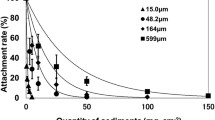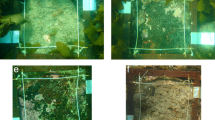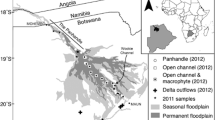Abstract
We examined factors affecting the abundance and distribution of epiphytes (fouling) on the sublittoral kelp Ecklonia radiata. We first assessed the importance of phlorotannins as chemical defences against epiphytes by (a) correlating epiphyte loads on different parts of the thallus with the phlorotannin content of those tissues, and (b) experimentally testing the effects of variation in phlorotannin concentration against the settlement and growth of gametes of Ulva lactuca, a common epiphyte in the system. Tissue phlorotannin content was, at best, only weakly related to epiphyte loads, with r 2 values typically <0.10. Inhibition of Ulva gametes only occurred at concentrations >10 mg l−1, which is 5 orders of magnitude greater than levels of phlorotannins in the water column around beds of E. radiata, and 1–3 orders of magnitude greater than estimated levels in the boundary layer at the surface of the plant. We concluded that phlorotannins have a negligible impact on patterns of epiphytism on E. radiata, and proceeded to investigate other factors influencing the distribution and abundance of epiphytes. In our samples the relative age of different parts of the thallus was strongly correlated with epiphyte abundance, with epiphyte densities greatest on the oldest tissue and least on the youngest. Distal parts of the thalli also had greater epiphyte loads than basal parts. Field experiments in which kelp tissue was suspended at two heights in an E. radiata forest for varying lengths of time confirmed the importance of the length of time that the tissue was in the water, and its height in the water column, to the development of an epiphyte community. Comparison of epiphyte loads on tissue from primary (smooth) and secondary (rough) laminae in these experiments indicated that surface rugosity also affected fouling. Macroherbivores were rare on E. radiata, and abundances of mesofauna and epiphytes were positively related, suggesting that grazers were not important determinants of patterns of epiphyte abundance. Although phlorotannins have been previously suggested to play an important role as defences against epiphytes, we suggest that water-soluble compounds such as phlorotannins are less likely to be effective defences against epiphytes than non-polar metabolites, which can adhere to the surface of the producing organism.
Similar content being viewed by others
Author information
Authors and Affiliations
Rights and permissions
About this article
Cite this article
Jennings, J., Steinberg, P. Phlorotannins versus other factors affecting epiphyte abundance on the kelp Ecklonia radiata . Oecologia 109, 461–473 (1997). https://doi.org/10.1007/s004420050106
Issue Date:
DOI: https://doi.org/10.1007/s004420050106




